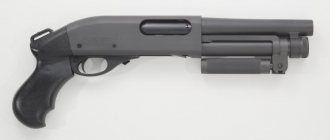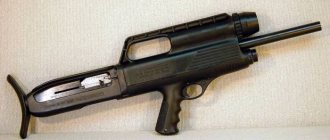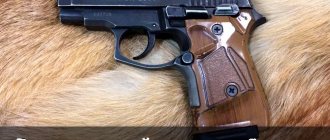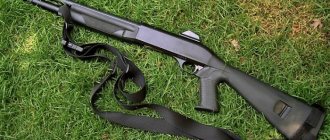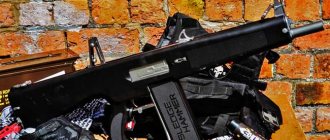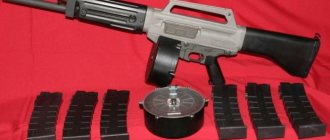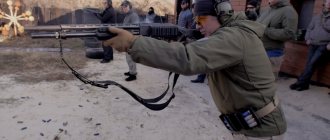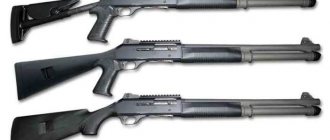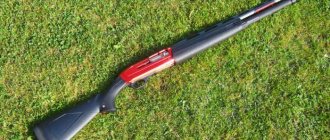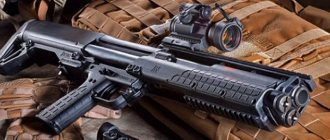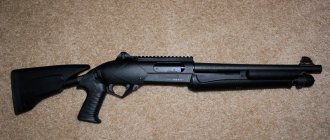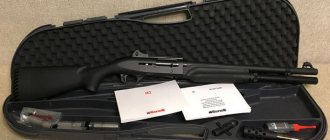| This article need additional quotes for verification . |
"Boomstick" redirects here. For diving weapons, see stick strike.
Not to be confused with broom.
An open-break sawn-off shotgun, commonly known as
a lupara
A sawn-off shotgun
(also called
a sawed-off shotgun
,
shotgun
,
shorty
or
arrow
) is a type of shotgun with a shorter pistol barrel—usually less than 18 inches (46 cm)—and often a shortened or missing stock. Despite the colloquial term, barrels, strictly speaking, do not necessarily have to be cut to size. Barrels can be manufactured in shorter lengths as an alternative to traditional longer barrels. This makes them easier to transport due to their smaller profile and lighter weight. The design also allows the weapon to be easily maneuvered in tight spaces, a feature that the military strives for. close combat units, law enforcement SWAT team users and home defense purposes. Due to the shorter barrel length, any sawed-off shotgun with a magazine tube will have reduced capacity.
In the 1930s, the US, UK and Canada required a permit to own these firearms.[1] They are subject to legal restrictions depending on the jurisdiction. They are used by military and police services around the world.
Content
- 1 Description
- 2 Legal restrictions 2.1 Australia
- 2.2 Canada
- 2.3 Czech Republic
- 2.4 Germany
- 2.5 Ireland
- 2.6 United Kingdom
- 2.7 United States
- 2.8 Other
Specifications
The performance characteristics of the Serbu Super-Shorty shotgun are presented in the table.
| Type | Manual pump-action reloading |
| Caliber, chamber | 12.76 mm |
| Length | 419 mm (with 165 mm barrel) |
| Barrel length | 165, 229 or 305 mm |
| Weight | 2.04 – 2.72 kg |
| Magazine capacity | 2, 3 or 4 cartridges |
Technically, the Super Shorty shotgun is a sawn-off shotgun with a 165 mm barrel and a total length of 420 mm. The weight of the gun without cartridges is about 2.5 kg. The under-barrel tubular magazine holds three 12-gauge cartridges. The forend has been removed, replaced by a folding handle, which also serves to reload the gun and is connected by a rod to the bolt. The gun does not have a butt, instead there is a pistol-type handle or a bird's head.
Serbu Super-Shorty shotguns combine compactness and mobility with the high stopping power of a 12-gauge shotgun. The effective range for firing buckshot from these shotguns is about 7-10 meters, while at these ranges the characteristics of the shot of the buckshot charge differ little from those for full-size shotguns, all the shot falls into a circle with a diameter of 2-3 inches.
Description
Compared to a standard shotgun, a sawn-off shotgun has a shorter firing range due to the lower muzzle velocity; however, its reduced length makes it easier to maneuver and conceal. The powerful and compact weapon is especially suitable for use in small spaces, such as close quarters combat in a military context. Crews of military equipment use a short-barreled rifle as a combat weapon. auxiliary weapon. In urban combat zones, military teams often use entry shotguns when breaking and entering doorways.
Many jurisdictions have minimum legal barrel lengths for shotguns.[2] making these more concealable guns inaccessible for criminal purposes. Many U.S. gun manufacturers have not offered sawed-off shotguns to the public since 1934, when shotguns with a barrel length of less than 18 inches were limited, although they had previously been sold. To comply with NFA rules, anyone can fill out the Form 1 "manufacture form" and purchase and approve an AMERICAN DOLLAR$200 Tax Stamp for the gun in question to legally reduce its barrel length to less than 18 inches by cutting the barrel or replacing it with a shorter one. [2][3]
A sawn-off shotgun is often an unofficial modification of a standard shotgun. In countries where handguns are more expensive or difficult to obtain, criminals may turn a legally purchased or stolen gun into a concealed weapon.
The term is often applied to illegal weapons that are created by cutting off the barrel of a standard shotgun. The barrel of a gun without a tubular magazine can be cut to any length; pump-action or semi-automatic shotguns usually have a tubular magazine attached to the bottom of the barrel, which limits the practical minimum barrel length to about the length of the magazine tube, unless it is also modified, which is technically much more difficult than shortening the barrel. Repeating shotguns with box magazines do not lose case capacity when sawed, but they are much less common than magazines with tubular magazines. Shotguns manufactured with barrels that do not exceed the legal minimum length often fall into special categories.
Review of the best shotgun models
Let's look at several of the most popular and technically advanced models of shotguns that can be successfully used for self-defense and hunting:
Mossberg 500 Tactical Persuader
Mossberg 500 is a smoothbore hunting shotgun with a pump-action reloading system (a feature of this pump-action shotgun is a safety located on top of the receiver and controlled by the thumb).
A classic model, production of which began back in 1962. It is characterized by a wide range of applications, being used for self-defense, for hunting and in various law enforcement agencies. The structural elements of the shotgun are made of steel, while the body of the model is aluminum, and the fore-end and butt are made of plastic or wood. The fuse is located on top of the receiver, which is very convenient.
Super Black Eagle 3
The model is excellent for use in difficult climatic conditions. The key feature of this shotgun is the presence of a special stock that helps reduce recoil. The weapon is characterized by excellent rates of fire, power, accuracy of fire and reliability, and a certain aggressive design is an additional advantage, allowing this weapon to be successfully used for self-defense.
Remington 870
The Remington 870 is a shotgun with an under-barrel tubular magazine for 8 rounds and a longitudinally sliding forend (“pump-action” shotgun). A
popular model of shotgun, which has been produced by an American manufacturer since the middle of the last century. Thanks to the special shape of the fore-end, the gun is easily recognizable. The design is characterized by a lower supply of cartridges, while the ejection of spent cartridges is carried out from the side. The high reliability of this model is due to the presence of a solid receiver, which further reduced the weight of the shotgun, making it more convenient to use.
Legal restrictions
See also: Overview of gun laws by country
Many countries have introduced legal restrictions on sawn-off shotguns. Below are restrictions for certain countries. Although they are not listed here, they are also subject to laws governing weapons in general.
Australia
In Victoria, the barrel of a shotgun cannot be shortened to change the category into which the shotgun is classified. In some states, any change in barrel length requires permission from the Chief Commissioner of Police.[4]
Canada
A hand-operated (not semi-automatic) short-barreled shotgun is not subject to restrictions as long as the barrel length has not been changed from the original factory length. There is no legal minimum for shotgun barrels unless they are pistols; Shotguns with barrels up to 8.5 inches are available in Canada.[5][6]
Reducing the length of a shotgun barrel to less than 457 mm (18 in) by sawing, cutting or "otherwise" by anyone other than a recognized gun manufacturer is prohibited.[7]
Czech
Short-barreled shotguns are universal weapons of category B and therefore require a permit and a weapons license (zbrojní průkaz), including the self-defense category.
Germany
In Germany, ownership of a sawn-off shotgun is legal with a firearms license (Waffenbesitzkarte), just like any other firearm. The restrictions apply only to pump-action shotguns, for which the minimum barrel length must be 45 cm and the minimum overall length must be 90 cm. Other shotguns can be of any length. If the barrel length is less than 30 cm or the overall length is less than 60 cm, the firearm is considered a handgun and is treated according to the law.
Ireland
Shortening the barrel of a shotgun or shotgun carries a presumptive minimum sentence of five years in prison for a first-offense conviction and a mandatory five-year sentence for a second or subsequent offense.
United Kingdom
The United Kingdom requires side-by-side, over-and-under, breech-action and lever-action shotguns to meet a minimum barrel length specification of 24 inches if they appear on the shotgun's certificate. If a firearm is certified, the applicant has demonstrated "good cause" for owning it, they must conform to the standard configuration with a minimum barrel length of 12 inches and a minimum overall length of 24 inches, as with other Section 1 firearms.
Shotguns certified as shotguns must not have a magazine or have a permanent magazine that can hold no more than two rounds. Firearms that are certified firearms are not subject to any magazine restrictions.
Semi-automatic and pump-action shotguns, whether shotgun or firearms certified, must always meet the specification of a minimum barrel length of 24 inches and a minimum overall length of 40 inches.[8]
Muzzleloading firearms that are certified firearms are exempt from any restrictions on barrel and overall length. A shotgun certified smoothbore muzzleloader will meet the standard specification of a minimum barrel length of 24 inches.
United States
Under the National Firearms Act (NFA), it is unlawful for a private person to possess a cut-off modern smokeless powder shotgun (a shotgun with a barrel length of less than 18 inches (46 cm) or a minimum overall length of the weapon, including a minimum barrel length of 18 inches, less than 26 inches (66 cm) )) (less than USC Title II), without tax registration from the Bureau of Alcohol, Tobacco, Firearms and Explosives, requiring a background check and a tax of $200 or $5 per transfer, depending on the specific manufacturing circumstances of the modern sawn-off shotgun being transferred . Gun trusts have become an increasingly popular means of registering SBS with the BATFE.[9] Short-barreled muzzleloading black powder shotguns are not illegal under federal law and do not require a tax stamp permit, although they may be illegal under state law. As with all NFA regulated firearms, a new tax stamp must be purchased before each transfer. Interstate transfers must be made through a Federal Firearms Licensee (FFL), while intrastate transfers can be made between two entities.[10]
In the US, shotguns originally manufactured without a shoulder stock (and therefore not legal shotguns), with an overall length of less than 26 inches, are classified as "Any Other Firearm"BATFE and have a $5.00 transfer tax if manufactured by a manufacturer with a qualifying Class 2 Taxpayer Special Occupational Firearms License. To convert an existing shoulder-stock shotgun to a shotgun or an existing pistol-grip shotgun to “any other weapon,” an individual must pay the standard NFA tax of $200.[2]
Another
[clarification needed
]
Additional restrictions may apply in many other jurisdictions. State and local laws may prohibit civilians from owning handguns entirely. In addition, some types of firearms that are generally considered to be classified as short-barreled shotguns (SBS) may not be considered SBS under the law. A shotgun is legally defined as a shoulder-mounted firearm that fires projectiles. Shotguns and receivers that have never had any type of stock mounted on them are not shotguns because they cannot be shoulder mounted. Therefore, cutting one below 18 inches of barrel and/or 26 inches of overall length cannot produce SBS since the firearm was never a shotgun. The Bureau of Alcohol, Tobacco, Firearms and Explosive recognizes these firearms as shotguns, which are all other weapons (AOWs). Unlike SBS, AOW only incurs a $5 tax and can move between states without federal government approval. To maintain AOW status, it must not have a stock (which makes it an SBS) or a rifled slug barrel (which makes it a destructive device (DD) if the barrel diameter is greater than 0.5 inches). Firearms of this type have typically been around for over 100 years. These weapons, manufactured with a barrel length of less than 18 inches, are not considered a sawed-off shotgun because they were not manufactured with a shoulder stock. Weapons with these characteristics are classified as shotguns produced in heavy bore and 12/20 shotgun bores, as opposed to illegal sawed-off shotguns, and are not considered destructive devices. Any firearm capable of firing a shotgun cartridge manufactured after the 18-inch minimum barrel size restrictions were implemented is considered an illegal sawed-off shotgun.
Types of shotguns
The Benelli M4 Super 90 is a smoothbore, semi-automatic repeating autoloading shotgun developed in Italy by Benelli Armi SpA.
In most cases, shotguns are shotguns of the smoothbore type, in which the energy of a fixed projectile is used to fire shotguns. The direct predecessor of the shotgun is the musket, which nowadays can also be used for riot control and self-defense.
Regardless of the type, shotguns are designed for combat at short distances (up to 25 meters). This is due to two features:
- No threading inside the barrel. Rifled shotguns are extremely rare.
- Using shot as a projectile. Due to the large spread of metal balls, the shotgun's damaging ability at long distances is insignificant.
At the moment, the following types of shotguns are distinguished:
- Single-barreled. A classic option that is highly valued by experts for its ease of use and unpretentiousness.
- Double-barreled (similar to rifles). Such weapon models have a higher lethality compared to their single-barreled counterparts. Currently, such models are especially common among hunters.
- Multi-barreled. Such models can have more than two barrels and are not found among civilian weapons.
Regarding the reloading method, the following shotgun options are distinguished:
- Pump-action. This is the most popular design with which many people associate the very concept of a shotgun. It assumes the presence of a movable front handle, by sliding which the bolt group moves. Thus, when moving the handle back and forth, the spent cartridge case is ejected, and a new cartridge is sent into the chamber. This mechanism has a higher rate of fire compared to classic rifles and double-barreled shotguns, allowing you to keep your hand on the handle until the magazine is completely empty.
- Lever type. This is a multi-shot weapon, the reloading procedure in which occurs manually, through a semicircular movement of the trigger guard. To change the cartridge, it should be passed around the trigger. At the moment, this reloading method is considered somewhat outdated and is largely inferior to its pump-action counterparts.
- Self-loading or automatic shotgun. This is a weapon that allows you to fire in automatic mode. Here the recharging process occurs without direct human participation. Regarding the device, such designs resemble automatic rifles and machine guns. Today this is the most advanced type of such weapon, characterized by a high rate of fire. Civilians are not allowed to own this type of shotgun.
Shotgun Ammo
The cartridge is grapeshot, has an ideal accuracy of 80-85% at a distance of 35 meters
. In addition to the cheapness of this weapon (about half the price of a classic rifle), the shotgun attracts attention with a wide variety of ammunition. In this case, the short firing range can be easily compensated by the significant power of the shot, due to which the shotgun is characterized by truly high penetration ability. This criterion determined the use of a shotgun for assault purposes.
Police and military use
This short-barreled shotgun was produced with a reduced barrel length rather than being modified after its manufacture.
Historical military uses of sawed-off shotguns include use as the primary weapon of Confederate cavalry during the American Civil War. These muzzle-loaded weapons were used primarily for close combat and complemented the availability of more traditional close-combat weapons such as the saber or carbine. The availability of the original weapons and the ability to use single ball, shot, or a combination of both depending on the situation were the reasons why they were initially desirable by those creating Confederate mounted units. Over time they were replaced as more conventional weapons became available and the tactical use of cavalry shifted towards use as mounted infantry.
H&K Fabarm FP6 Entry - has a 14-inch barrel and is classified in the USA as a short-barreled shotgun.
In modern usage, minimum length and barrel length restrictions apply for civilian purposes only; Military and police departments may produce short-barreled shotguns, and major manufacturers offer special models with 10 to 14 inch (25 to 36 cm) barrels as shotguns or combat shotguns for use in confined spaces. They are commonly called "entry shotguns" because they are often used to enter buildings where ease of handling is more important than the increased ammunition capacity of a longer gun. Breaking rounds provide another use for very short shotguns. These cartridges usually consist of sintered powdered metal, but normal buckshot or round birdshot will also work. The shotgun is used for burglary by placing the gun close to the door lock (0 to 2 inches, 0 to 5 cm) and firing at a 45 degree angle down through the door between the lock or latch and the door frame. The impact of the projectile(s) opens a hole in the door, removing the latch or locking bolt. As it passes through the door, the crushed or sintered metal quickly disperses and, since it is directed downwards, the risk of harm to passengers on the other side of the breached door is minimized. Destruction pistols used by police and military can have barrels up to 10 inches (25 cm) long, and they often have only a pistol grip rather than a full stock. Some models use a special cup-shaped muzzle extension to further reduce the risk of injury to the shooter from shrapnel. Since there are so few shots, any 3 shot sporting shotgun can be shortened and used as a penetration shotgun.
Design features and principle of operation
Structurally, the Super-Shorty line of shotguns is based on 12 and 20 caliber shotguns (on special order) of the Remington 870, Mossberg 500 or Maverick 88 shotgun models.
The Serbu Super-Shorty smoothbore shotgun is a legal modification of full-size pump-action shotguns to what is popularly referred to as a “sawn-off shotgun.”
The design of Serbu Super-Shorty shotguns is similar to the corresponding basic models. The alteration first of all consists of carefully shortening the barrel, magazine tube and its feed spring. Instead of a traditional movable forend, the weapon was equipped with an original folding handle, while the weapon can be reloaded both with the handle folded and unfolded, and instead of the usual butt, with a pistol grip.
Technically, the Serbu Super-Shorty is a repeating smoothbore shotgun with manual reloading using a fore-end that moves back and forth (pump-action shotgun). The barrel is locked by a swinging cylinder installed in the bolt behind the breech.
The safety on the Mossberg 500 model is located on the top of the rear of the receiver, and on the Remington 870 model it is located on the rear of the trigger guard.
The Serbu Super-Shorty shotgun can be equipped with barrels with a length of 165, 229 or 305 mm. At the customer's request, a special adapter for knocking out door locks and hinges (breaching adapter) can be installed on the barrel, allowing the barrel to be rested reliably and safely for the shooter and weapon against the door before firing.
A tubular magazine located under the barrel is loaded with one cartridge at a time through a special window in the bottom of the receiver. Depending on the length of the barrel, the magazine capacity also varies, which is designed for 2, 3 or 4 cartridges (another cartridge may be in the chamber of the weapon).
The receiver is steel. Sights, as a rule, are absent. To carry a weapon, a swivel for attaching a single-point belt can be located on the handle.
Barrel length and shot spread
It is a common misconception that reducing the length of a gun's barrel itself has a significant effect on shot pattern or spread; this only becomes true when the barrel length is reduced to less than 50% of the typical length.[11] A standard-length barrel (e.g., 28 inches) is long enough to move the weapon's center of gravity away from the body and give it ergonomic weight, and to ensure the barrel extends into the shooter's field of view to the right. reach the target, and also make the weapon safer since it is difficult to accidentally point a long gun at your own body. The pattern is primarily affected by the type of cartridge fired and the choke, or constriction, typically found at the muzzle of a shotgun barrel.
The main reason for changing the pattern is that cutting off the end of the barrel removes the choke, which usually extends only two inches (5 cm) inward from the muzzle. This causes the cylinder to bore, resulting in the widest spread typically found in shotgun barrels. (See choke for more information on the effects of chokes. See shotgun shell for information on spreader loads.) See shot pattern details. However, many skilled gunsmiths can recut and reinstall the choke in a shortened barrel.
Civil use
Sawed-off sawn-off, hand-cocked hammers and double triggers are known as lupara
("wolf shot") in Italy and, although it is associated with organized crime, was originally used by Sicilian farmers and shepherds to protect their vineyards and herds of animals.[12]
In rural North India, where it is seen as a weapon of authority and prestige, it is known as dunali
, literally meaning "two pipes". It is especially common in Bihar, Purvanchal, Uttar Pradesh, Haryana and Punjab.
The light weight of a short-barreled shotgun, especially in configurations that lack a significant stock, encourages some users to use short "mini-cases" with lower shot and powder loads for convenient everyday use.[13]
Criminal use
In the UK, Australia, Canada and New Zealand, where pistols are not easily obtained, a sawed-off shotgun was a common weapon in armed robberies during and shortly after the 1960s, and is the use most people associate with the weapon.
Bank robber Clyde Barrow modified his Browning A-5 shotgun by cutting the barrel to the same length as the magazine tube and shortening the stock by 5–6 inches (125–150 mm) to make it more concealable. Attached to either end of the pistol's butt was a small 10–12 in (250–300 mm) long strap that looped around his shoulder, concealing the pistol between his arm and chest under his jacket, like a shoulder holster. The pistol was quickly raised and fired from the shoulder under which it was located. Barrow named him "Whippit" as he could easily "pull him out".
